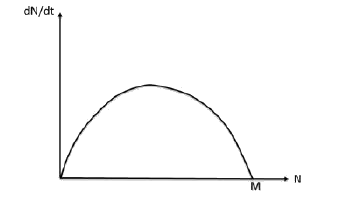If natality is represented by -B
If mortality is represented by -D
if immigration is represented -I
If emigration is represented by -E
If population density at time t+1 is represented by
Nt+1=Nt−[(B+1)]−[(D+E)]
Nt+1=Nt+[(B+1)]−[(D+E)]
Nt+1=Nt+[(B+1)]+[(D+E)]
Nt+1=Nt−[(B+1)]+[(D+E)]
The correct Answer is:B
To find the population density at time t+1, we need to consider the effects of natality, mortality, immigration, and emigration on the initial population density. Let's break this down step by step:
Step 1: Understand the terms
- Natality (B): This represents the number of births in the population during a specific time period. It contributes positively to the population density.
- Mortality (D): This represents the number of deaths in the population during the same time period. It contributes negatively to the population density.
- Immigration (I): This refers to individuals of the same species that move into the population from elsewhere. It also contributes positively to the population density.
- Emigration (E): This refers to individuals of the population that leave to go elsewhere. It contributes negatively to the population density.
Step 2: Define the initial population density
Let n be the population density at time t.
Step 3: Write the equation for population density at time t+1
The population density at time t+1 can be calculated by starting with the initial population density and adjusting for the changes due to natality, mortality, immigration, and emigration.
The formula can be expressed as:
nt+1=n+B−D+I−E
Step 4: Substitute the variables
From the question, we know:
- Natality is represented as B
- Mortality is represented as D
- Immigration is represented as I
- Emigration is represented as E
Thus, we can rewrite the equation as:
nt+1=n+B+I−D−E
Step 5: Finalize the expression
The final expression for the population density at time t+1 is:
nt+1=n+B+I−(D+E)
Conclusion
This equation shows how the population density at time t+1 is affected by the initial population density, the number of births, the number of individuals immigrating, and subtracts the number of deaths and individuals emigrating.
- Natality (B): This represents the number of births in the population during a specific time period. It contributes positively to the population density.
- Mortality (D): This represents the number of deaths in the population during the same time period. It contributes negatively to the population density.
- Immigration (I): This refers to individuals of the same species that move into the population from elsewhere. It also contributes positively to the population density.
- Emigration (E): This refers to individuals of the population that leave to go elsewhere. It contributes negatively to the population density.
Let n be the population density at time t.
The population density at time t+1 can be calculated by starting with the initial population density and adjusting for the changes due to natality, mortality, immigration, and emigration.
nt+1=n+B−D+I−E
From the question, we know:
- Natality is represented as B
- Mortality is represented as D
- Immigration is represented as I
- Emigration is represented as E
nt+1=n+B+I−D−E
The final expression for the population density at time t+1 is:
nt+1=n+B+I−(D+E)
This equation shows how the population density at time t+1 is affected by the initial population density, the number of births, the number of individuals immigrating, and subtracts the number of deaths and individuals emigrating.
Similar Questions
Knowledge Check
- Question 1 - Select One
If BOY is represented as 42, then GIRL is represented as
A40B43C48D46 - Question 2 - Select One
If b is represent → birth rate
If d is represent → death rate
if dN is represent → increase or decrease in population size
Then exponetial growth is represented byAdN/dt=(b+d)NBdN/dt=(b−d)NCdN/dt=(d−b)NDdN/dt=(d−b)N - Question 3 - Select One
In the graph below. where N is population size and tis time. M represents
 Aspecific growth rate.BMedian population sizeCcarrying capacityDminimum population size without going extinct.
Aspecific growth rate.BMedian population sizeCcarrying capacityDminimum population size without going extinct.
The density of a body is represented by the expression
View SolutionIf one
 represents 35 pens, then
represents 35 pens, then  will represent View Solution
will represent View SolutionVital index of a population is represented as
View SolutionGrowth of human population is represented currently by
View SolutionDifferent factors affecting population density are given below. I,B,D and E represent:
 View Solution
View Solution
